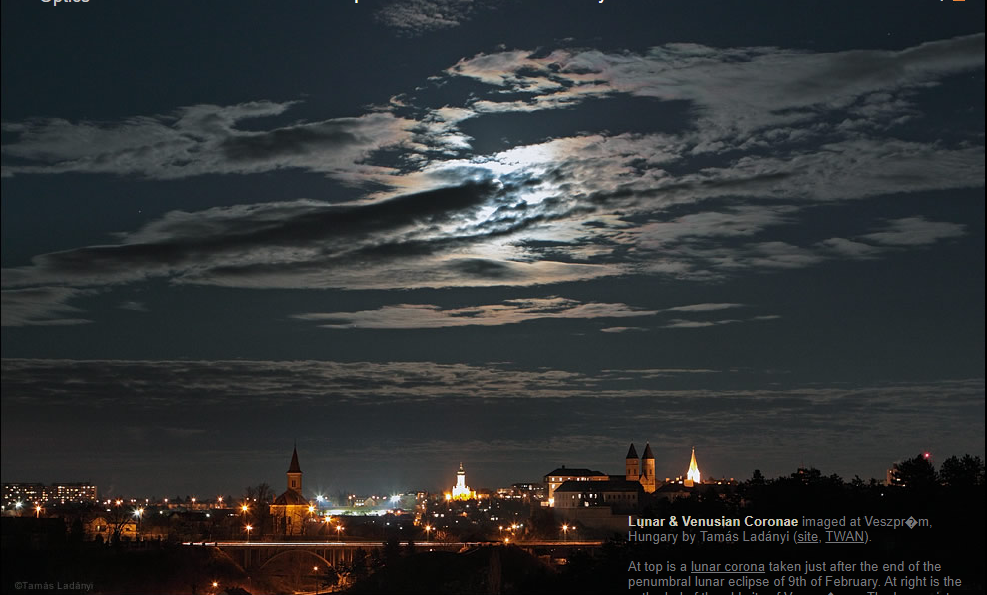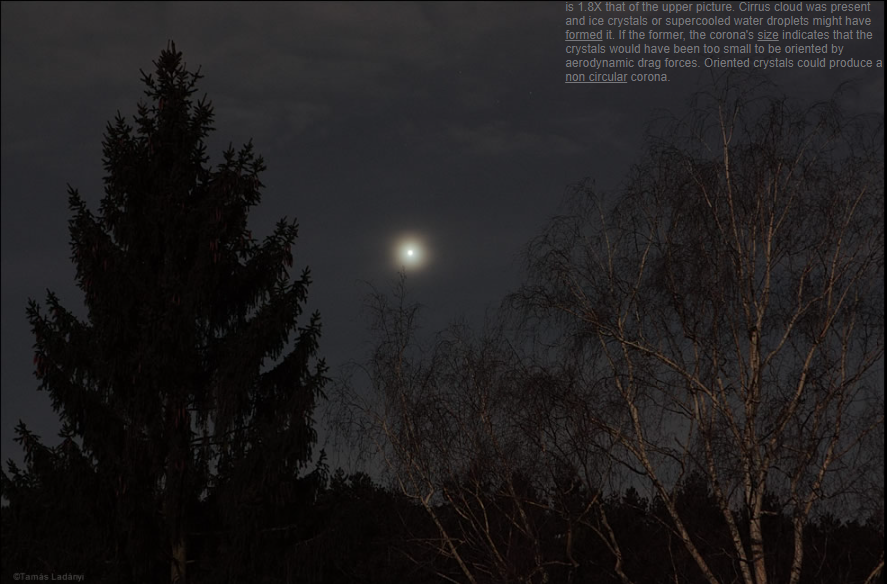Corona: Moon & Venus
Corona: Moon & Venus
Have you ever looked up at the night sky and noticed a beautiful halo of light surrounding the Moon or Venus? This phenomenon is known as a corona, and it occurs when light from these celestial objects interacts with tiny water droplets or ice crystals in the Earth's atmosphere. While the existing content provides a brief overview of lunar and Venusian coronae, let's delve deeper into this fascinating optical phenomenon.
Lunar Corona
A lunar corona is a stunning sight to behold. It occurs when the Moon's light passes through a layer of thin clouds or haze containing tiny water droplets. These droplets act as miniature lenses, bending and scattering the light in different directions. As a result, a circular halo of colors appears around the Moon, with blue being the innermost color and red being the outermost.
One interesting aspect of lunar coronae is that they are often observed during or after a lunar eclipse. During a penumbral lunar eclipse, the Moon passes through the Earth's outer shadow, causing a dimming effect. After the eclipse, when the Moon emerges from the shadow, its light interacts with any moisture present in the atmosphere, creating a captivating corona.
Venusian Corona
Similarly, Venus can also exhibit a corona when viewed under certain atmospheric conditions. Unlike the Moon, which produces a corona due to water droplets, Venus creates its corona through interactions with ice crystals or supercooled water droplets. The presence of cirrus clouds in the atmosphere plays a crucial role in forming the Venusian corona.
The size and shape of a Venus corona can vary depending on the size and orientation of the ice crystals or supercooled water droplets. If the crystals are too small to be influenced by aerodynamic drag forces, they will remain randomly oriented. In such cases, the resulting corona will appear circular. However, if the crystals align themselves in a specific orientation, the corona may exhibit a non-circular shape.
Capturing the Beauty
Photographers and skywatchers often seize the opportunity to capture the ethereal beauty of lunar and Venusian coronae. With the right equipment and timing, stunning images can be obtained, showcasing the intricate details of these atmospheric optical phenomena.
To photograph a corona, it is essential to use a camera with manual settings and a tripod to ensure stability. Adjusting the exposure settings can help capture the delicate colors and intricacies of the corona. Additionally, using a telephoto lens or zooming in can bring out finer details, making the image even more captivating.
The Science Behind Coronae
Understanding the science behind coronae involves studying the interaction of light with particles in the Earth's atmosphere. The process begins when light from the Moon or Venus passes through the atmosphere, encountering tiny particles such as water droplets or ice crystals. These particles scatter the light in different directions, causing it to spread out and form a corona.
The size of the particles plays a significant role in determining the appearance of the corona. Smaller particles tend to scatter shorter wavelengths of light, such as blue and violet, more effectively than longer wavelengths like red and orange. This is why the inner part of a corona appears bluish, while the outer part appears reddish.
Furthermore, the distribution of particles within the atmosphere can influence the size and shape of the corona. If the particles are uniformly distributed, a circular corona will be observed. However, if there are variations in particle density or orientation, the corona may exhibit irregularities and asymmetrical shapes.
Coronal Effects on Sky Colors
Coronae not only create stunning halos around celestial objects but also affect the colors of the surrounding sky. As light passes through the atmosphere and interacts with particles, it scatters in different directions, leading to changes in sky coloration. These effects can range from subtle variations to dramatic shifts in hue.
During a corona event, the sky around the Moon or Venus may appear slightly darker than usual due to the scattering of light away from the observer's line of sight. Additionally, the presence of a corona can cause a reddening or bluish tint in the sky, depending on the scattering properties of the particles involved.
Exploring Atmospheric Optics
Coronae are just one example of the fascinating phenomena that occur in our atmosphere. Atmospheric optics encompasses a wide range of optical effects, including rainbows, halos, and mirages. By studying these phenomena, scientists gain insights into the behavior of light and the properties of particles in our atmosphere.
Next time you find yourself gazing at the night sky, take a moment to appreciate the beauty of a corona. Whether it graces the Moon or Venus, this captivating optical phenomenon reminds us of the intricate interactions between light and the atmosphere. So, keep your eyes peeled for these celestial halos and marvel at the wonders of atmospheric optics.

Lunar & Venusian Coronae imaged at Veszpr�m, Hungary by Tamás Ladányi (site, TWAN).
At top is a lunar corona taken just after the end of the penumbral lunar eclipse of 9th of February. At right is the cathedral of the old city of Veszpr�m. The lower picture taken about an hour later shows a Venus corona. The scale is 1.8X that of the upper picture. Cirrus cloud was present and ice crystals or supercooled water droplets might have formed it. If the former, the corona's size indicates that the crystals would have been too small to be oriented by aerodynamic drag forces. Oriented crystals could produce a non circular corona.

Note: this article has been automatically converted from the old site and may not appear as intended. You can find the original article here.
Reference Atmospheric Optics
If you use any of the definitions, information, or data presented on Atmospheric Optics, please copy the link or reference below to properly credit us as the reference source. Thank you!
-
<a href="https://atoptics.co.uk/blog/corona-moon-venus/">Corona: Moon & Venus</a>
-
"Corona: Moon & Venus". Atmospheric Optics. Accessed on April 19, 2024. https://atoptics.co.uk/blog/corona-moon-venus/.
-
"Corona: Moon & Venus". Atmospheric Optics, https://atoptics.co.uk/blog/corona-moon-venus/. Accessed 19 April, 2024
-
Corona: Moon & Venus. Atmospheric Optics. Retrieved from https://atoptics.co.uk/blog/corona-moon-venus/.